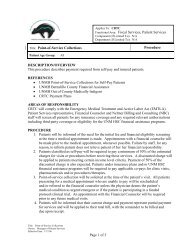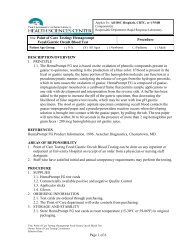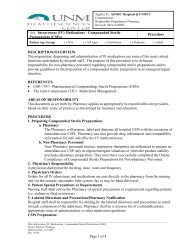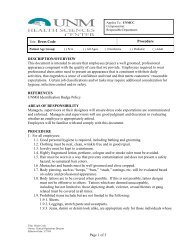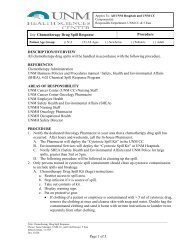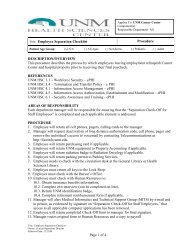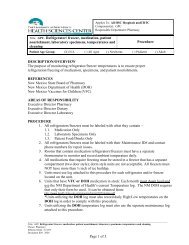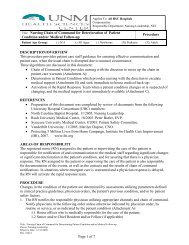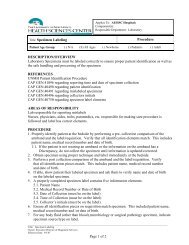Page 1 of 25 DESCRIPTION/OVERVIEW The purpose of this ...
Page 1 of 25 DESCRIPTION/OVERVIEW The purpose of this ...
Page 1 of 25 DESCRIPTION/OVERVIEW The purpose of this ...
You also want an ePaper? Increase the reach of your titles
YUMPU automatically turns print PDFs into web optimized ePapers that Google loves.
CARE OF PEDIATRIC CENTRAL CATHETERS<br />
Type <strong>of</strong> Line CVC Catheter Broviac Catheter Groshong Catheter Venous Access Ports Peripherally Inserted<br />
Central Catheter (PICC)<br />
Dressing: Use central line<br />
dressing kit.<br />
Type <strong>of</strong> Dressing: use a<br />
bio-occlusive (Op-site,<br />
Tegaderm, etc.) type <strong>of</strong><br />
dressing. Place a BioPatch<br />
over the insertion site.<br />
Frequency <strong>of</strong> Dressing<br />
Change: change every 7<br />
days or PRN loss <strong>of</strong><br />
occlusiveness. Change<br />
BioPatch every 7 days.<br />
Change non-occlusive<br />
gauze dressings every 72<br />
hours and PRN if dressing<br />
is soiled or wet.<br />
Type <strong>of</strong> Dressing: use a<br />
bio-occlusive (Op-site,<br />
Tegaderm, etc.) type <strong>of</strong><br />
dressing unless otherwise<br />
ordered. Place a BioPatch<br />
around the catheter at<br />
insertion site.<br />
Frequency <strong>of</strong> Dressing<br />
Change: change every 7<br />
days or PRN loss <strong>of</strong><br />
occlusiveness. Change Bio<br />
Patch every 7 days.<br />
Change non-occlusive<br />
gauze dressings every 72<br />
hours and PRN if dressing<br />
is soiled or wet.<br />
Type <strong>of</strong> Dressing: use a<br />
bio-occlusive (Op-site,<br />
Tegaderm, etc.) type <strong>of</strong><br />
dressing<br />
Frequency <strong>of</strong> Dressing<br />
Change: change every 7<br />
days or PRN loss <strong>of</strong><br />
occlusiveness.<br />
Change non-occlusive<br />
gauze dressings every 24<br />
hours and PRN if dressing<br />
is soiled or wet.<br />
Type <strong>of</strong> Dressing:<br />
New Port Placement:<br />
when the port is new,<br />
steri-strips should be<br />
applied to the incision and<br />
the site should be left open<br />
to air. After the site heals,<br />
no dressing is necessary<br />
unless port is in use.<br />
Port in Use: when the<br />
port is in use, the noncoring<br />
(Huber) needle<br />
must be secured and a bioocclusive<br />
dressing should<br />
be applied and left in<br />
place until the needle is<br />
changed. <strong>The</strong> needle is<br />
left in place for up to 7<br />
days.<br />
Type <strong>of</strong> Dressing: use a<br />
bio-occlusive (Op-site,<br />
tegaderm, etc.) type <strong>of</strong><br />
dressing. Place a BioPatch<br />
around catheter at<br />
insertion site.<br />
Frequency <strong>of</strong> Dressing<br />
Change: the initial<br />
dressing should be<br />
changed within 24 hours.<br />
After the initial dressing<br />
change, the dressing<br />
should be changed every 7<br />
days or PRN. Change<br />
BioPatch every 7 days.<br />
Remove the dressing from<br />
distal to proximal to avoid<br />
pulling out the catheter.<br />
For all catheter sites, clean the site with chlorhexidine prepstick in a scrubbing motion, working from side to side for 30 seconds. Also, clean the catheter with chlorhexidine.<br />
Apply the dressing – be sure to coil the line before placing the tegaderm– up to – but not including the access ports. Observe the site for signs and symptoms <strong>of</strong> infection. Be<br />
sure to date, time, and initial the dressing. Do not use BioPatch on Pediatric Oncology patients at <strong>this</strong> time.<br />
Patients on the Pediatric Hematology/Oncology Service with broviac central line catheters will have the dressing changed every seven days, with the line coiled on top <strong>of</strong> a<br />
sterile 2x2 gauze covered with a bio-occlusive dressing as per procedure listed within <strong>this</strong> document. If catheter is covered by a 2x2 gauze, the dressing will be changed every<br />
72 hours.<br />
Cap and Cap Changes<br />
Frequency <strong>of</strong> Cap Changes: for all types <strong>of</strong> lines, needle-less access caps should be on all ports. Needle-less access caps should be changed<br />
every 72 hours (3 days). If a hub-to-hub access is done for a blood draw or CVP reading, a new injection cap should be placed on the line when<br />
finished.<br />
Changing the Cap: Clamp all lines (except Groshong). Prep the cap/catheter hub for sixty seconds with an alcohol or chlorhexidine. Remove the<br />
old cap and apply the new cap using sterile technique. Unclamp the line (if in use) and place a courtesy tab on the cap/hub. Be sure to date,<br />
time, and initial the cap change on the courtesy tab.<br />
_________________________________________________________________________________________________________________<br />
Title: Venous Access Device<br />
Owner: Clinical Education Department<br />
Effective Date: 07/27/05<br />
<strong>Page</strong> 16 <strong>of</strong> <strong>25</strong>



